Coronavirus cases are rapidly increasing in Gujarat. More than 14,000 cases are being reported in the State daily while the healthcare sector is overwhelmed with high demands it is unable to meet. Furthermore, fatalities due to COVID are much higher than the State government’s official death toll.
On April 15, Sandesh News aired a 50-minute interview with Gujarat Chief Minister Vijay Rupani. This video has been uploaded on YouTube in two segments. In the second segment at the 14-minute mark, the journalist asked, “There is one question that I must ask, please try to answer this question with an open heart so that the people of Gujarat gain some faith…Taking the example of Rajkot, the death toll is around 80. However, the government’s official death toll is very low. There is a large inconsistency between the toll and what is being reported by the government.”
CM Rupani elaborated on the Indian Council of Medical Research (ICMR) guidelines related to recording deaths due to COVID-19. According to him, as per ICMR, the primary cause of death of COVID-19 patients who had pre-existing diseases like cancer and diabetes is not COVID-19.
Rupani said, “As per ICMR, there are two reasons for the cause of death. The first is purely due to COVID and the second is due to comorbidity. For example, a patient who is 75 to 80 years old has cancer in the third stage. Their immunity is broken and if they get COVID and dies, then the cause of death is cancer as the primary reason and COVID is the secondary reason. Patients with 500 points diabetes are admitted. Therefore, the cause of death is diabetes and COVID is the secondary reason.”
He added, “Therefore, a doctoral committee is formed to audit each death. They distinguish the cause of death as primary or secondary. For example, if 100 deaths take place and only 20 are reported (under COVID), then 80 are due to primary reason (non-COVID) and 20 is due to the secondary reason.”
Gujarat CM gave the same statement to The Times of India on April 19 – “The method of recording COVID deaths has been stipulated by ICMR and all states, including Gujarat, are following it.”
COVID-19 deaths don’t add up in Gujarat
As per The Quint and Gujarat Samachar, multiple dead bodies are being simultaneously cremated in the State. The Print reported that the death tolls at Ahmedabad’s six crematoriums were at least 84 on April 16. However, the Health and Family Welfare Department of Gujarat reported just 25 deaths in the city.
A day prior to The Print report, The Hindu reported that on April 16 state health bulletin recorded 78 deaths related to COVID-19. However, The Hindu found that at least 689 bodies were either cremated or buried following COVID-19 protocols on the disposal of bodies.
India Today also looked into the allegations that Gujarat is under-reporting COVID-19 deaths. According to the channel’s on-the-ground assessment, the “toll could be a lot higher”. Reports from Varanasi, Bhopal, and Telangana exhibit a similar pattern.
What do ICMR guidelines say?
Alt News studied ‘Guidance for appropriate recording of COVID-19 related deaths in India’ (view PDF) by ICMR and the National Centre for Disease Informatics and Research (NCDIR) and found that CM Rupani’s statement is misleading. As per NCDIR director Dr Prashant Mathur these guidelines issued in May 2020.
Page 3 states, “Patients may present with other pre-existing comorbid conditions such as chronic obstructive pulmonary disease (COPD) or asthma, chronic bronchitis, ischemic heart disease, cancer and diabetes mellitus. These conditions increase the risk of developing respiratory infections and may lead to complications and severe disease in a COVID-19 positive individual. These conditions are not considered as UCOD (underlying cause of death) as they have directly not caused death due to COVID-19. Also, a patient may have many co-morbid conditions, but only those that have contributed to death should be recorded in Part 2.”
Mathur told Alt News, “Death of a COVID-19 patient with comorbidity, such diabetes, and cancer, can happen due to COVID-19 as the contributing or underlying cause.” He also stated, “Irrespective of the cause of death it is important to use COVID-19 related mortality codes on Medical Certificate of Cause of Death (MCCD) forms to understand the impact of the pandemic accurately.”
Expert opinion
Alt News spoke to Associate Professor Chalapati Rao at Australia National University. Last year, he wrote a WHO editorial titled ‘Medical certification of cause of death for COVID-19′. After reading CM Rupani’s statement to Sandesh News, he said, “In the process of explaining the ICMR guidelines, CM Rupani used the phrases primary and secondary cause of deaths. The appropriate terms to be used are underlying and contributory causes, and these labels are assigned to causes based on their placement on various sections of the MCCD. For primary mortality statistics, the magnitude of mortality from COVID-19 needs to be assessed from the perspective of COVID-19 as an underlying cause. However, for monitoring the impact of the pandemic, all deaths with COVID-19 mentioned on the certificate, irrespective of whether listed as an underlying or as a contributory cause, are included for the analysis. Hence, the accurate listing and placement of COVID-19 on MCCD are of critical importance for detailed mortality assessment.”
Rao further explained, “More crucially, if a patient has tested positive for COVID-19, then the MCCD should state it clearly along with the prefix ‘confirmed’ so that the State has accurate data and thus takes appropriate measures. Certifying physicians also have the discretion to record ‘suspected COVID-19’ on MCCD, if a test result was not available but the clinical picture was suggestive of COVID infection. The term COVID-19 should always be prefixed with confirmed or suspected, to enable accurate data analysis.”
Alt News has written to the Gujarat Chief Minister’s Office and will update the article if we get a response.
In order to explain nuances related to documenting COVID related deaths our report is split into:
- Understanding medical terms related to death
- Death Certificate vs Medical Certificate of Cause of Death
- Process of recording death
- Case study: MCCD prepared by Shalby Hospital
Understanding medical terms related to death
The guidelines by ICMR/ NCDIR define ’cause of death’ (CoD) as, “all those diseases, morbid conditions/abnormalities, injuries which either resulted in or contributed to death and the circumstances of the accident or violence which produced any such injuries”. It further adds that ‘mode of dying’ should be avoided as the cause of death because the former isn’t specifically related to the disease process.
As per the guidelines abbreviations should not be used for the cause of death. Here are some examples of CoD – respiratory acidosis, acute respiratory distress syndrome, disseminated intravascular coagulation, acute cardiac injury.
The following are some examples of ‘mode of dying’ as per ICMR/ NCDIR:
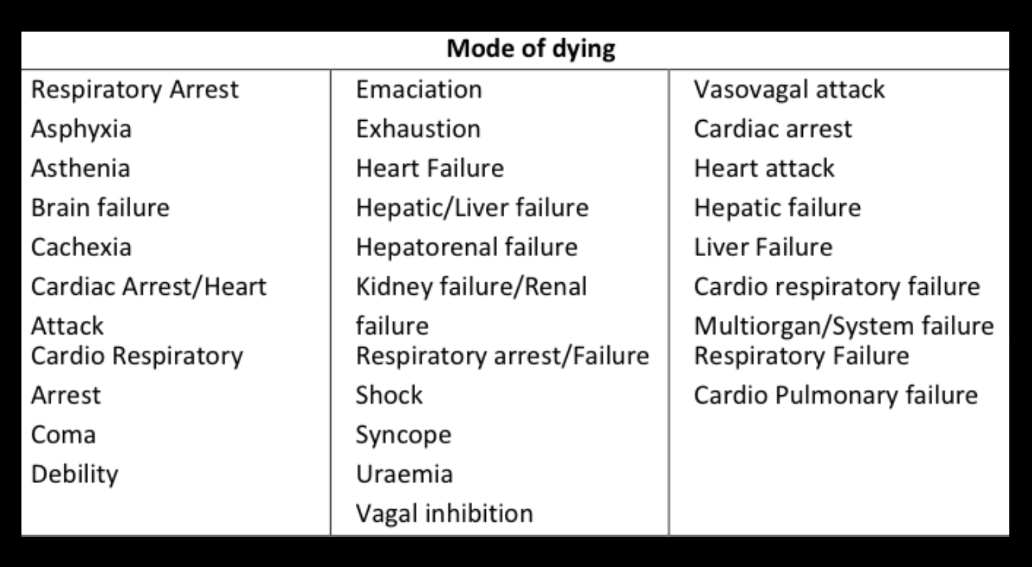
Death often results from the combined effect of two or more independent or related conditions, that is, one condition may lead to another, which in turn leads to a third condition and so on. Where there is a sequence, the disease or injury that initiated the sequence of events, called the underlying cause of death (UCoD), is recorded and reported.
ICMC/ NCDIR guidelines specify that UCoD is:
- The disease or injury which initiated the train of morbid events leading directly to death.
- The circumstances of the accident or violence that produced the fatal injury.
- All the morbid conditions or injuries consequent to the underlying cause relating to death are termed as antecedent and immediate cause.
Death Certificate vs Medical Certificate of Cause of Death (MCCD)
The readers should note that “death certificate” typically means the document issued by the Registrar as per the Registration of Births and Deaths Act, 1969 (view pdf). In order to obtain this, one must present a document for proof of death (MCCD or document offered after cremation), and other documents. For more details visit this government website. It this pertinent to note that the document issued by the Registrar doesn’t mention the cause of death.
MCCD is the certificate issued by the attending medical practitioner who had treated the person during admission in a medical institution or in the last illness (prior to death) while taking treatment from a physician outside of a medical institution.
MCCD is the process of recording and reporting death using standard Form 4 (institutional deaths) and Form 4A (non-institutional deaths) as per the rules of the Registration of Births and Death Act, 1969.
The MCCD form contains two parts:
- Part I to record the immediate and antecedent causes (highlighted in red)
- Part II to record the significant conditions that contributed to the death but were not part of the sequence of events leading to death (highlighted in green)
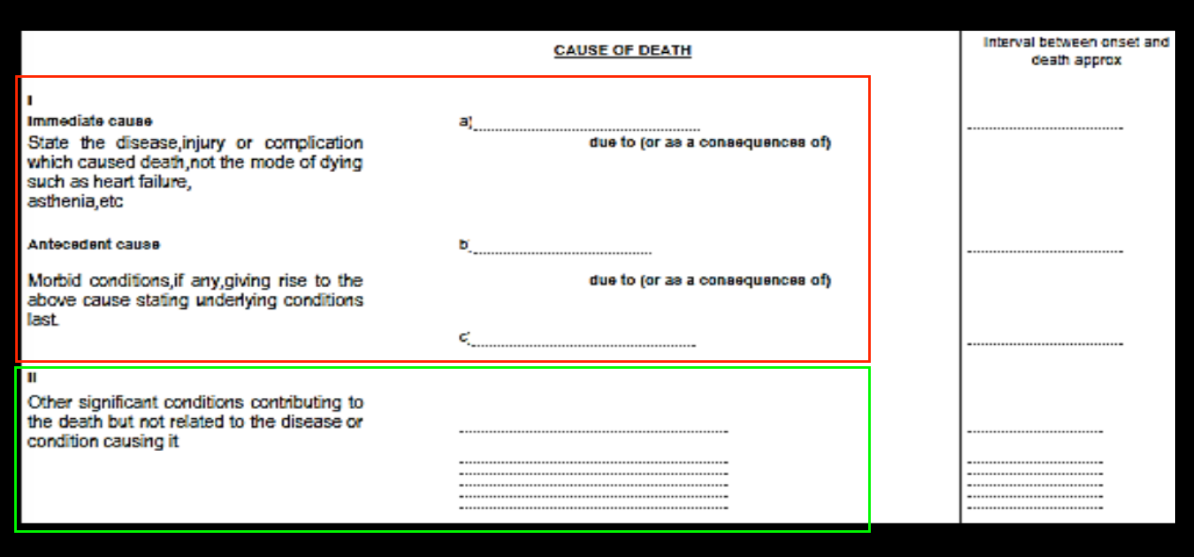
Thus, when CM Rupani mentioned primary and secondary causes of death, he was essentially referring to Part I and Part II of the MCCD.
Process of recording death
As per the guidelines, Part 1 should note the sequence of events leading to death.
- Line (a) is the immediate cause of death – the condition/disease that directly led to death/ that preceded death
- Line (b) notes cause of death antecedent (just after) to immediate cause should be entered
- Line (c) a cause further antecedent to this should be entered
The guidelines further specify that only one ’cause of death’ should be written in the above-mentioned spaces. It also states that disease, injury or complication that immediately preceded death can be the only entry in the MCCD form if only one condition is present at the time of death.
More crucially, the last line in Part 1 must list the underlying cause of death. It is the disease or condition that started the sequence of events between normal health to the immediate cause of death. Conditions if any, as a consequence thereof will be entered above it in ascending causal order of sequence.
Part 2 should include all other diseases or conditions believed to have unfavourably influenced the course of the disease leading to death but were not related to the disease or condition directly causing death. The following image lists some examples by ICMR /NCDIR, including cardiovascular disease and cancer.
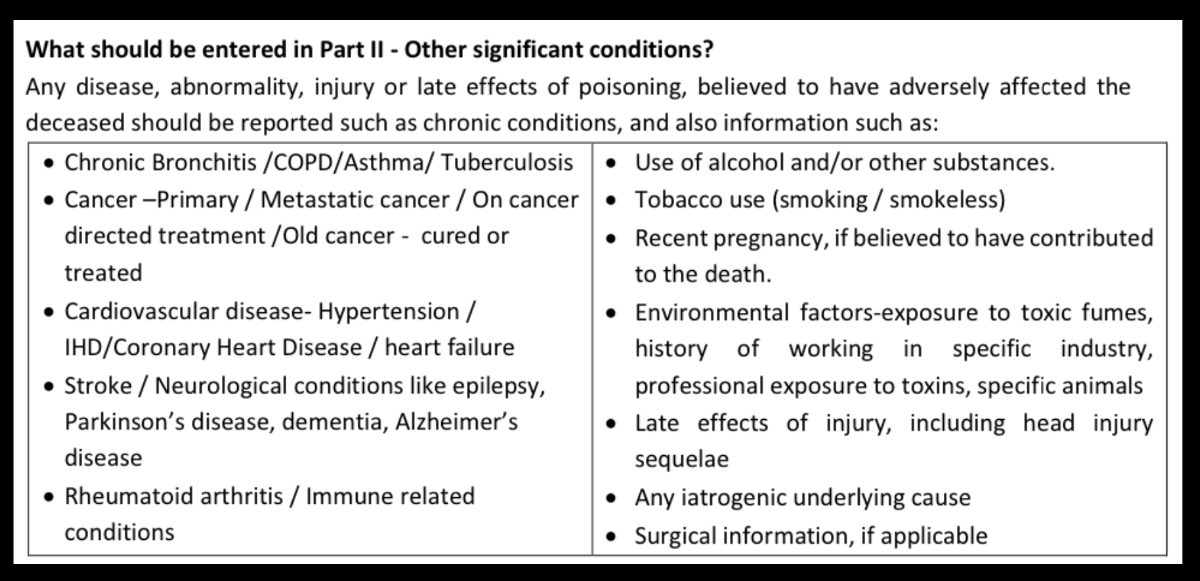
As per WHO guidelines, COVID-19 deaths are recorded using U07.1 (COVID-19) and U07.2 (test negative but has symptoms, test awaited and test inconclusive along with symptoms) codes to distinguish the diagnosis based on test and symptoms. The readers can view the document by WHO here. Both these codes must be clearly listed on the MCCD.
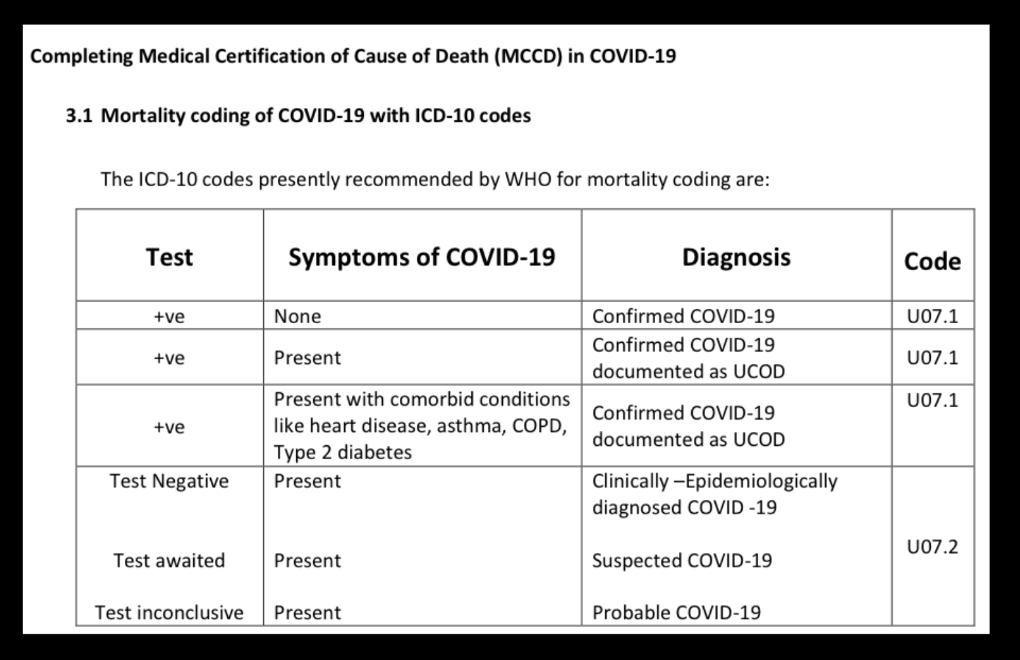
Multiple sample forms (Form 4/4A) have been included in the guidelines issued (view PDF) by ICMR and NCDIR. The following screenshots are of sample forms of two COVID-19 patients who had cancer and diabetes respectively. The guidelines are clear, if a patient is COVID-19 positive, it should be reflected in the antecedent cause of Part I (immediate and antecedent). The pre-existing diseases are recorded in Part II (significant conditions that contributed to the death but were not part of the sequence of events leading to death).
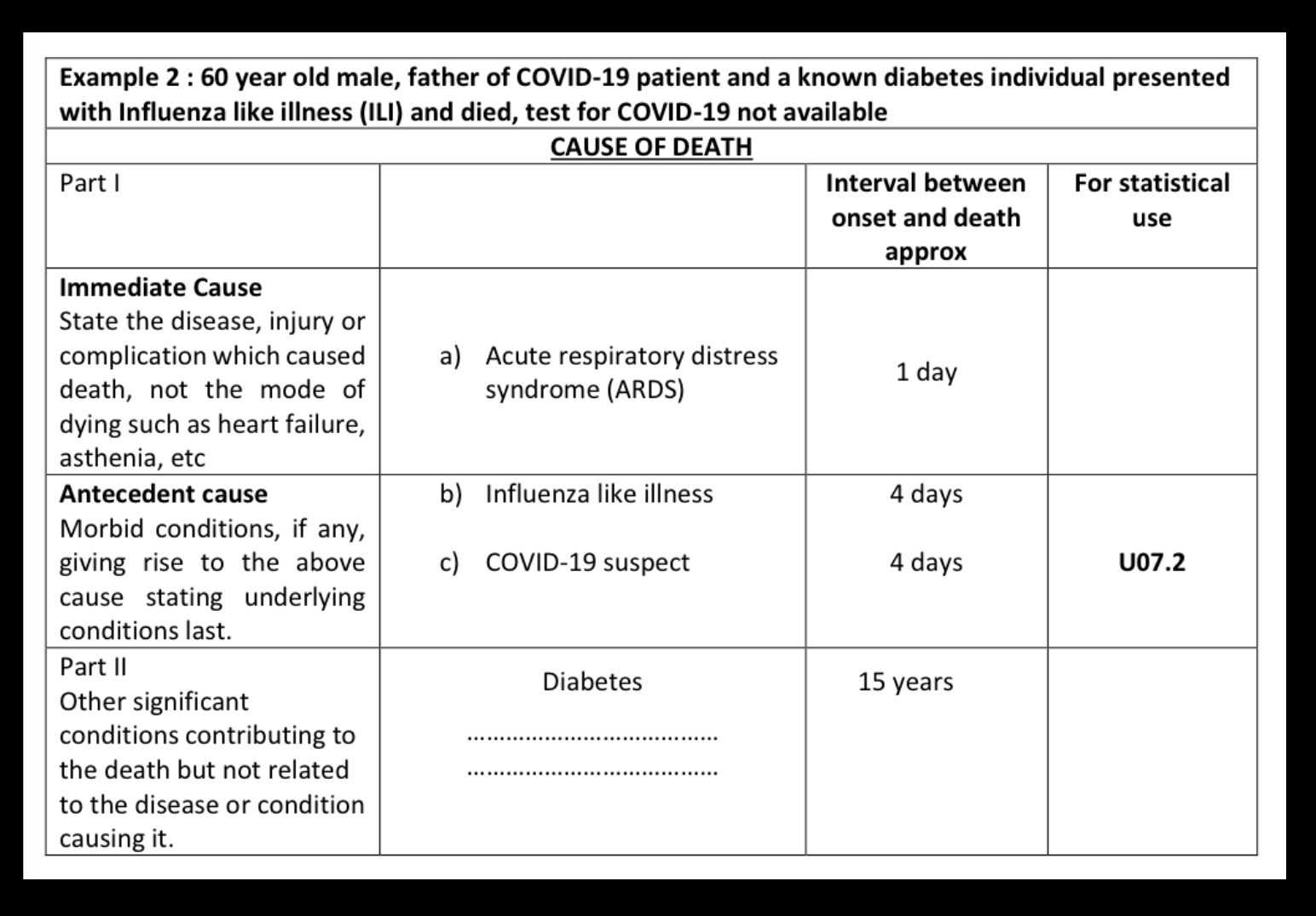
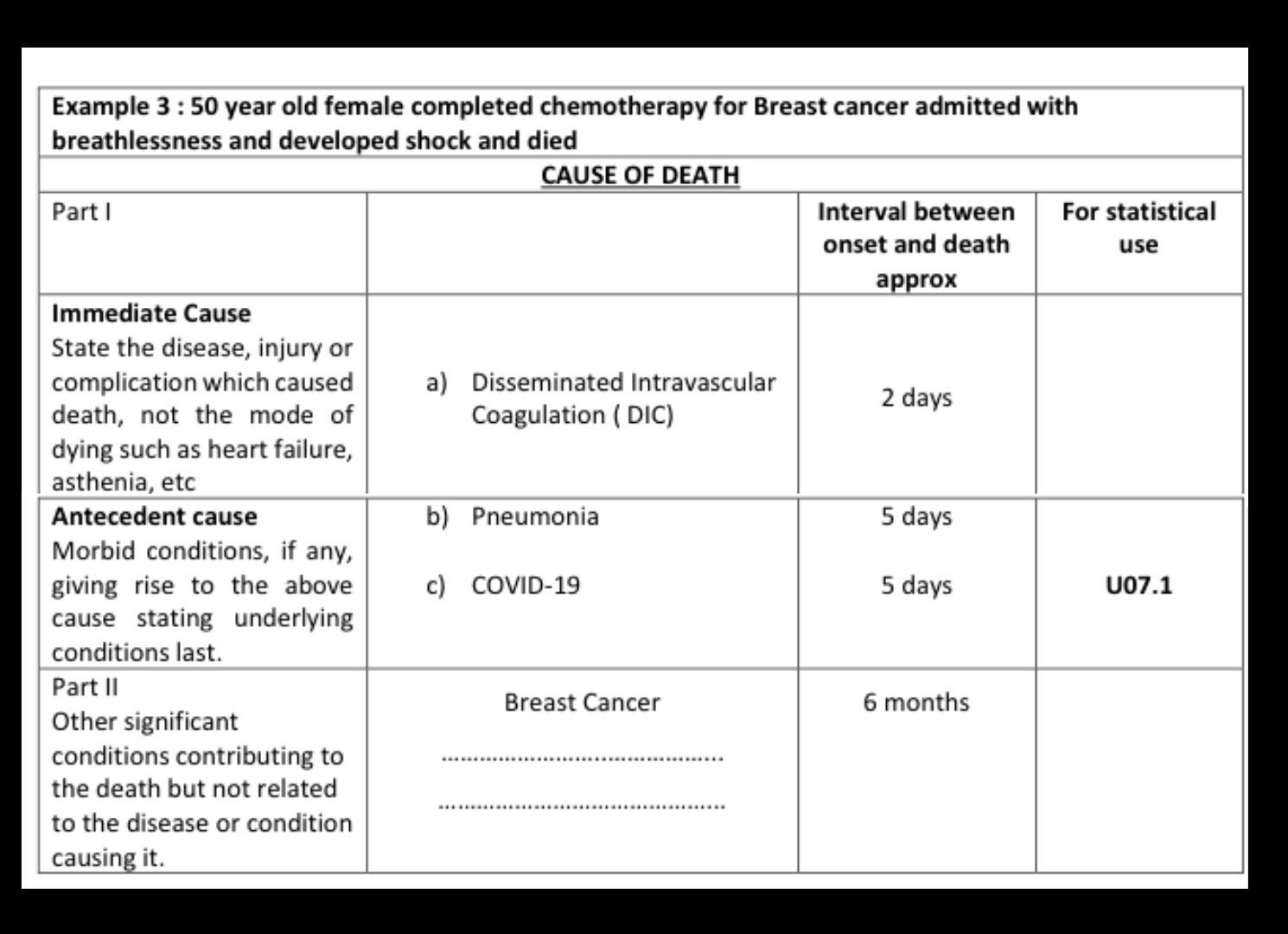
MCCD issued by Shalby Hospital
The Hindu had reported that 48-year-old COVID-19 positive Rupal Thakkar’s MCCD prepared by Ahmedabad’s Shalby Hospital mentioned “sudden cardiac arrest” as the cause of death. This was despite the fact that the form itself states that the mode of death such as heart attack should not be listed as the immediate cause of death.
Alt News spoke with Thakkar’s family and gained access to her COVID-19 test (dated April 12) and MCCD. Her brother Dipan gave us permission to highlight the flaws in the MCCD.
The MCCD was issued by Shalby Hospital’s consultant Dr Harshil Mehta. It is pertinent to note that the certificate doesn’t state that Thakkar was COVID positive despite the fact that she did test positive. Dipan also informed that as a result, the cremation took place without COVID-19 protocols. He also pointed out other errors such as age and time of admission to the hospital.
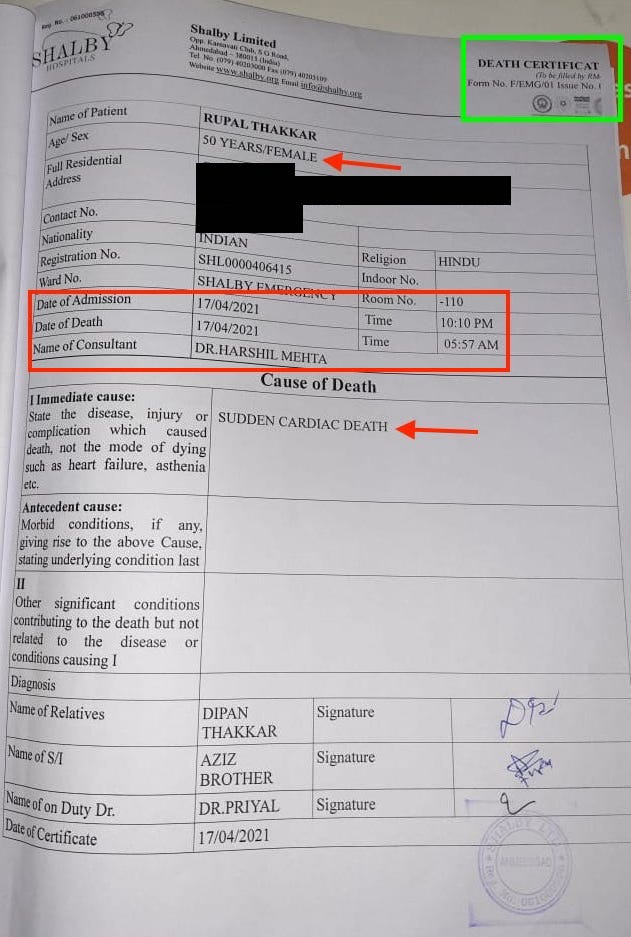
A corrected MCCD was subsequently issued by Shalby Hospital to Thakkar’s family. This version mentions COVID-19 as the antecedent cause of death. However, it does not list the COVID-19 specific identify codes on MCCD as per the guidelines. Furthermore, Shalby Hospital didn’t amend the immediate cause of death either.
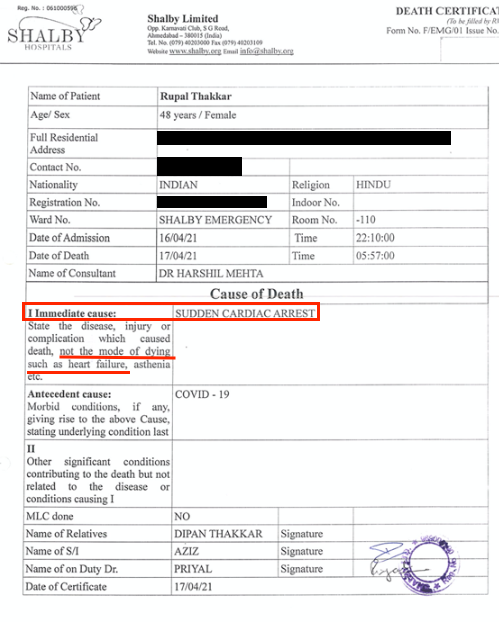
Discussing the MCCD issued by Shalby Hospital, Chalapati Rao said, “The phrase ‘sudden cardiac arrest’ should not have been listed as an immediate cause of death. It’s against the guidelines. However, this practice is commonly followed due to a lack of checks and balances. If at all stated, cardiac arrest should be further qualified with the mention of a preceding clinical condition or disease that precipitated the cardiac arrest, which would then be considered as the underlying cause of death.”
Alt News spoke with Dr Priyal, the on-duty doctor mentioned on Thakkar’s MCCD. She said that the MCCD was prepared as per Dr Mehta’s instructions. Dr Mehta in turn told Alt News, “Death certificate [MCCD] is just for our medical and corporation purpose. Whatever cause we are writing it is medically terminated and it for the data record. It is not certifying that the patient has died because of certain diseases.”
However, Section 3, 10 (3) of The Registration of Births and Deaths Act, 1969 (view pdf) states “in the event of the death of any person who, during his last illness, was attended by a medical practitioner, the medical practitioner shall, after the death of that person, forthwith, issue without charging any fee, to the person required under this Act to give information concerning the death, a certificate in the prescribed form stating to the best of his knowledge and belief the cause of death; and the certificate shall be received and delivered by such person to the Registrar at the time of giving information concerning the death as required by this Act.”
To conclude, Gujarat CM Rupani’s interpretation that comorbidities such as cancer or diabetes can be listed as the primary cause of death for COVID-related fatalities is not as per ICMR’s written guidelines for appropriate recording of COVID-19 related deaths in India.
[Note: An unpublished version of this report, still under review, was erroneously shared on social media. It carried a quote attributed to Dr Prashant Mathur, which wasn’t the final version of his comment. The error is regretted.]
Independent journalism that speaks truth to power and is free of corporate and political control is possible only when people start contributing towards the same. Please consider donating towards this endeavour to fight fake news and misinformation.




